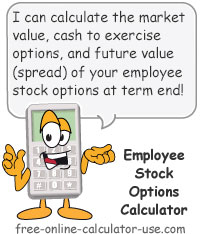IMPORTANT: Numeric entry fields must not contain dollar signs, percent signs, commas, spaces, etc. (only digits 0-9 and decimal points are allowed).
Click the Terms tab above for a more detailed description of each entry.
Step #1:
Enter the current market price per share of the company stock.
Step #2:
Enter the number of stock options you have granted to you.
Step #3:
Enter the number of years you would like to forecast the ESO's future value.
Step #4:
Enter the strike price per share of the options granted to you.
Step #5:
Enter the expected annual growth rate of the company stock.
Step #6:
If you would like to compare the value of your ESO's at up to three different growth rates, enter the rates you would like to compare.
Step #7:
Click the "Calculate Stock Option FV" button and then scroll down to view the results.


Follow me on any of the social media sites below and be among the first to get a sneak peek at the newest and coolest calculators that are being added or updated each month.